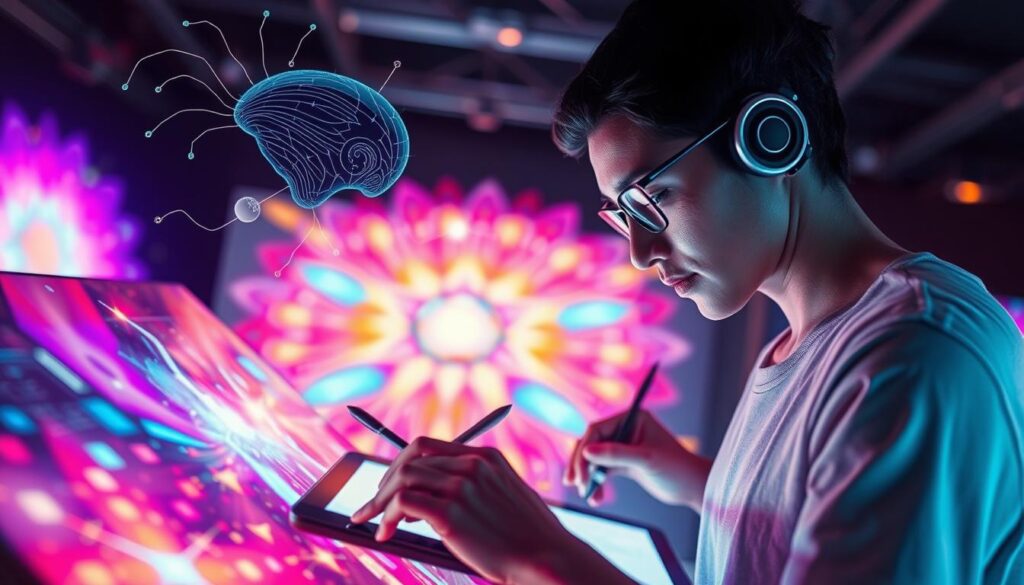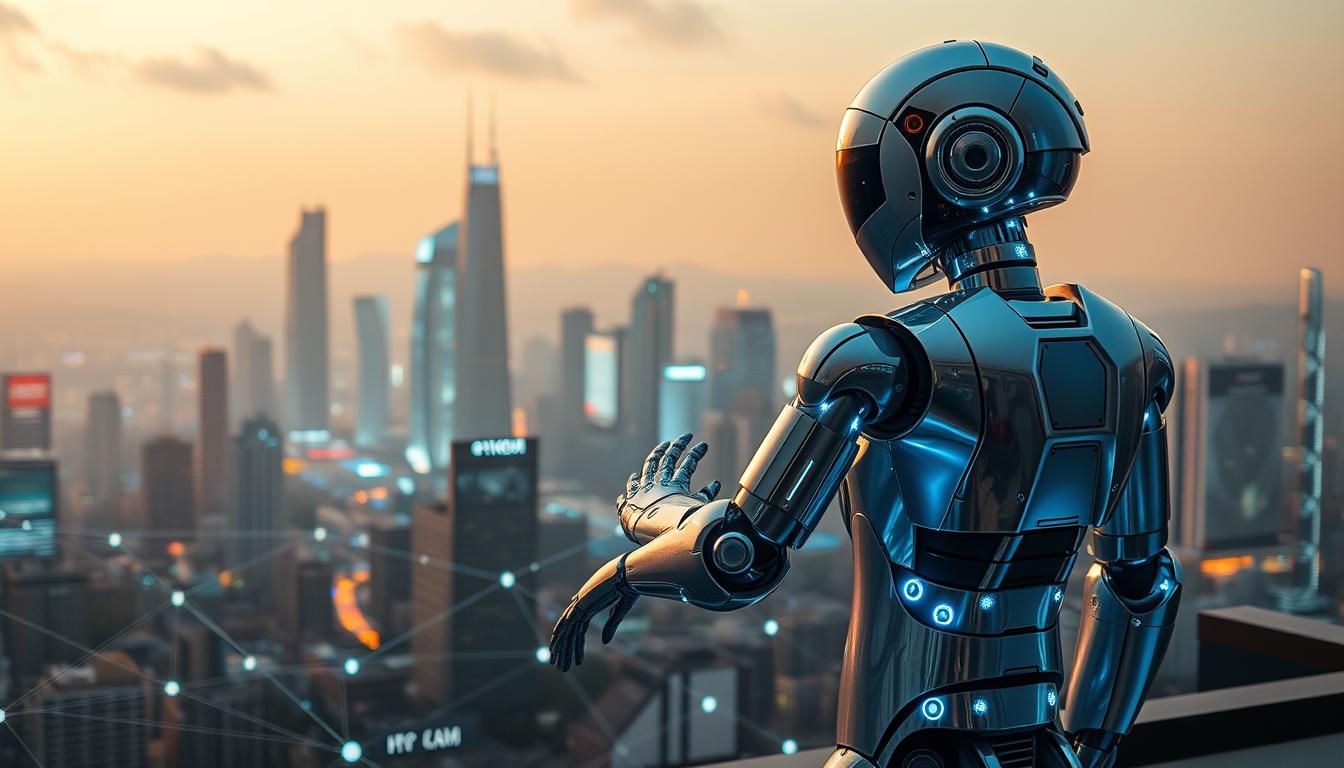Imagine if the top creative minds could work alongside machines, not against them. Generative artificial intelligence tools like ChatGPT and Midjourney are changing the game. Content creators wonder: Will these tools boost human creativity, or will they take its place?
Today’s future technology can write articles, design visuals, and even make music in seconds. A study found AI content is as good as human work but takes 90% less time. But, this raises big questions. How do we keep things real when machines can write like us? And who owns AI-created content?
The answers might surprise you. Modern tools aren’t just doing our jobs for us. They’re opening up new ways to work together. Writers use AI to get past creative blocks. Designers come up with hundreds of ideas in minutes. Musicians mix human feelings with machine precision.
The magic happens when we see this as a chance to work together, not compete. It’s about finding synergy.
Key Takeaways
- AI content tools now produce work comparable to human creators
- Successful teams combine machine efficiency with human judgment
- Copyright and ethics remain unresolved challenges
- Content creation becomes more accessible through AI assistance
- Hybrid workflows deliver faster results without sacrificing quality
- Creative industries must adapt to new economic models
- The best outcomes balance technological power with human insight
Understanding AI’s Impact on Content Creation
Artificial intelligence is changing how we make digital content. It’s making big waves in many fields. From doing simple tasks to making complex creative pieces, AI brings new chances and hurdles for creators.
The Evolution of AI Technologies
Today’s content tools come from big leaps in machine learning and deep learning. Early AI could only spot simple patterns. Now, advanced neural networks:
- Go through huge amounts of data fast
- Write text that sounds like it was written by a human
- Make images from text prompts
Tools like GPT-4 can understand language almost like a human. DALL-E can create images that look real from just text. This progress comes from three main things:
- More power to run complex algorithms
- Better data to train on
- Smarter ways to improve models
Major AI Tools Shaping Content
Now, there are special tools for every content need. Top platforms use different AI methods to offer:
- Tools for writing text, like blogs and social media posts
- Video editing helpers with auto-captioning
- Design tools that turn sketches into digital art
These tools help creators make content 10 times faster without losing quality. But, they work best when a human checks to make sure it fits the brand.
Benefits of AI-Generated Content
Companies using AI content tools see three big benefits:
- Scalability: Make lots of versions for testing
- Multilingual reach: Translate content well while keeping the right tone
- Personalization: Use customer data to make messages that fit
A Forbes study found that creators using AI get 40% more engagement. But, AI still can’t come up with truly new ideas. The human touch is still key for fresh concepts.
The Role of Human Creativity in an AI-Driven Era
AI tools make workflows smoother by automating tasks and analyzing data. Yet, human creativity is key to creating memorable content. The growth of cognitive computing has opened up new ways to blend machine efficiency with uniquely human skills like emotional intelligence and cultural awareness.

Finding the Sweet Spot Between Tech and Talent
Today’s content strategies are a mix of AI’s precision and human intuition. AI takes care of tasks like keyword optimization and trend forecasting. This lets creators focus on:
- Cultural context adaptation
- Emotional tone refinement
- Audience-specific nuance
A study on publisher-AI partnerships found teams that used AI for 30-40% of content creation saw 22% more engagement than fully automated content.
Keeping It Real in the Age of Algorithms
Authenticity shines when human editors refine AI-generated content into real stories. Brands that keep their voices consistent use cognitive computing as a brainstorming tool, not a replacement. Here are ways to keep content authentic:
- Human-led brand voice guidelines
- AI output validation checklists
- Quarterly creativity audits
Why Stories Still Matter Most
AI can’t match the emotional depth of great stories. While machines can come up with plot points, humans add:
- Personal experiences
- Cultural references
- Moral complexity
“The best AI-assisted stories feel like campfire tales, not spreadsheet outputs.”
As tech trend reports show, people value stories made by humans, with AI as an enhancer.
Ethical Considerations in AI-Generated Content
AI is changing how we create content, but it raises big ethical questions. Robotics and data science are making content spread faster. But we need to make sure creators and users are protected.
Ownership in the Age of Algorithmic Output
Copyright issues are popping up, like Getty Images suing Stability AI. It’s hard to say who owns AI-made art. We need new rules to keep up with AI in media.
Combating Synthetic Falsehoods
Teams at OpenAI and Google are working to stop fake news. They use special training to make tools like DALL-E safer. But we need to keep checking for bias and make sure AI is fair.
Building Trust Through Disclosure
The EU’s AI Act wants more openness about AI-made media. TikTok is now showing when content is AI-made. Brands that do this stay honest in the AI world.
We need to work together to make AI good and fair. As AI gets better, we must set rules to keep content real and honest. It’s up to everyone to make sure AI is trustworthy.
FAQ
How is AI transforming content creation processes?
AI tools like GPT-4 and DALL-E make tasks like writing and creating visuals easier. They use deep learning to understand data patterns. This means faster work and the ability to work in many languages, changing how we create content.
What are the limitations of AI-generated content?
AI is great at handling data but not so good at being creative or understanding cultural nuances. Tools like Jasper and Copy.ai need human help to add emotional depth and avoid repetition.
How can brands balance AI efficiency with human creativity?
Brands can use AI for research and drafts, then have humans refine the content. The Washington Post is a good example, using AI but keeping human journalists to keep stories engaging and trustworthy.
What ethical issues arise from AI-generated content?
There are worries about copyright, bias in AI tools, and the spread of false information. The EU’s AI Act and OpenAI’s transparency efforts aim to solve these problems.
How does AI impact content authenticity and transparency?
Google now asks for labels on AI-made political ads, and publishers use watermarks for synthetic content. Keeping content real involves human checks and clear labels, like Adobe Firefly’s system.
What role will humans play as AI content tools advance?
Humans will oversee AI, ensuring it’s ethical and culturally relevant. New skills in working with AI and designing workflows are emerging, like in cognitive computing and robotics.





